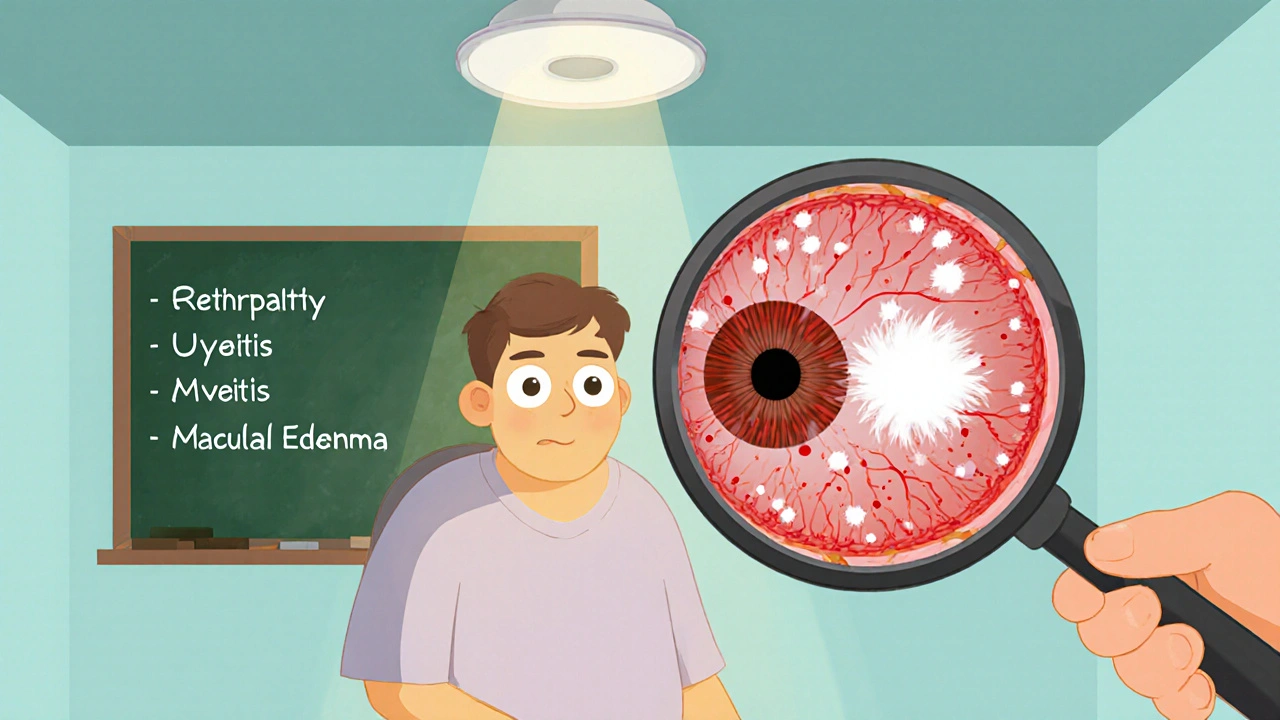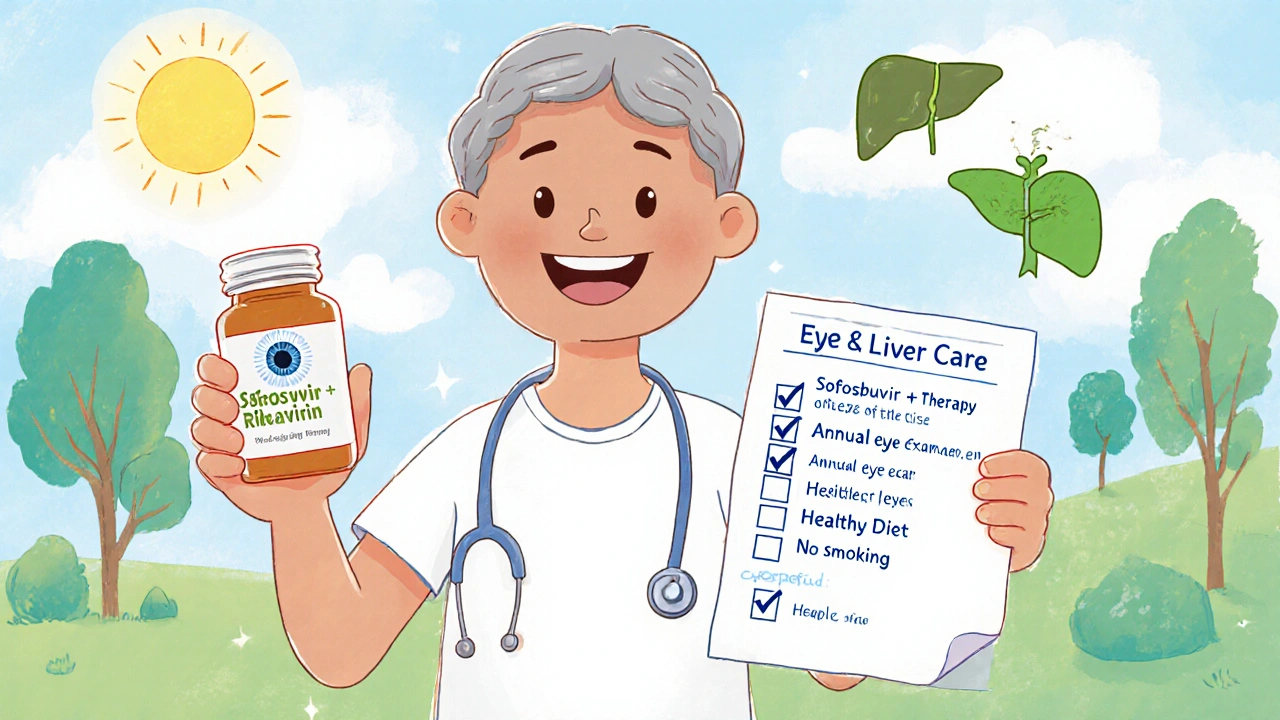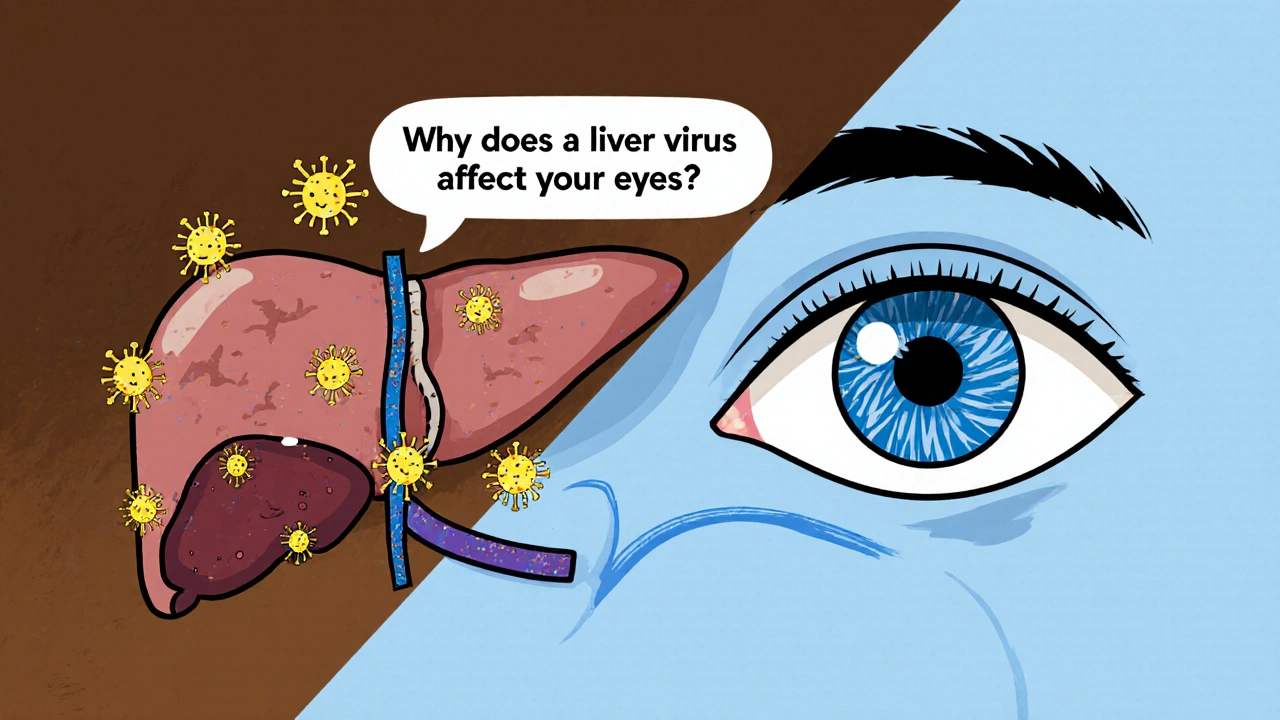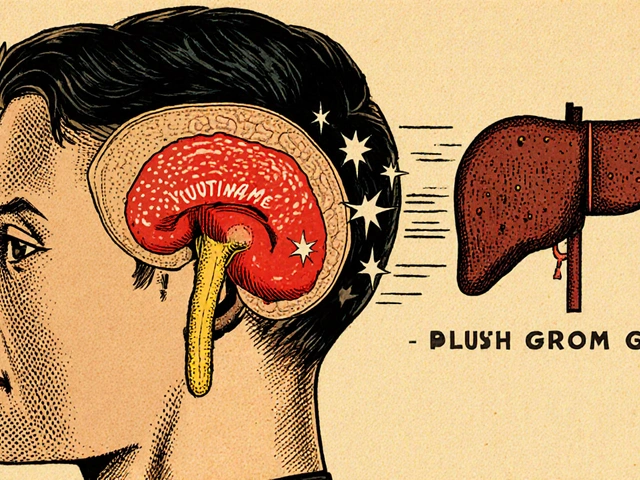Hepatitis C Eye Risk Calculator
Assess Your Eye Health Risk
This tool estimates your risk of developing eye complications based on key factors from the article. Results are based on research showing Genotype 3 HCV has 2x higher risk of uveitis and 22% retinopathy prevalence.
Ever wondered why a liver virus might make your eyes feel gritty or blurry? It’s not a coincidence - certain strains of hepatitis C, especially genotype 3, can affect the eye’s delicate structures. This article breaks down what the link looks like, how doctors spot it, and what you can do to protect both your liver and your sight.
What Is Genotype 3 Chronic Hepatitis C?
Genotype 3 Chronic Hepatitis C is a specific genetic variant of the Hepatitis C virus that tends to cause higher rates of liver fat accumulation and faster progression to cirrhosis. While the virus infects roughly 71 million people worldwide, about 30 % of infections belong to genotype 3, making it the second most common strain after genotype 1.
People with genotype 3 often experience steatosis (fatty liver) even without alcohol use, and that metabolic twist can ripple into other organ systems - the eye being a surprising example.
How Hepatitis C Affects the Body Beyond the Liver
The virus isn’t limited to liver cells. It circulates in the bloodstream, so immune complexes and inflammatory mediators can deposit in extra‑hepatic sites. Common non‑liver manifestations include mixed cryoglobulinemia, kidney disease, and skin rashes. The eye, with its rich blood supply and immune‑privileged status, can become a target for these inflammatory deposits.
When immune complexes settle in retinal vessels, they can trigger Retinopathy. Likewise, inflammation of the uveal tract can lead to Uveitis, while fluid leakage from damaged vessels may cause Macular edema. Each condition carries its own visual symptoms, ranging from mild glare to significant vision loss.
Eye Complications Linked to Hepatitis C
Researchers have documented several ocular findings in chronic hepatitis C patients:
- Retinopathy: Small hemorrhages, cotton‑wool spots, and microaneurysms visible on fundus exam. These are often asymptomatic but can indicate systemic vasculitis.
- Uveitis: Presents with eye redness, pain, photophobia, and blurred vision. It may be anterior (front of the eye) or posterior (affecting the retina).
- Macular edema: Fluid buildup in the central retina, causing central blurring and difficulty reading.
- Ocular surface disease: Dry eye symptoms due to altered tear film composition, reported in up to 15 % of HCV‑positive individuals.
Although these findings can appear with any HCV genotype, studies from 2023-2024 show a higher prevalence of retinal microvascular changes in genotype 3 cohorts, possibly tied to the strain’s stronger metabolic impact.
Why Genotype 3 Matters for Eye Health
Genotype 3’s tendency to cause steatosis leads to systemic insulin resistance and chronic low‑grade inflammation. Both factors impair endothelial function, making retinal vessels more vulnerable to damage.
One 2024 multicenter study of 1,200 HCV patients found that 22 % of genotype 3 carriers exhibited retinopathy versus 12 % of genotype 1 carriers, even after adjusting for age, smoking, and diabetes. The same study linked genotype 3 to a two‑fold increase in uveitis episodes requiring steroid therapy.
In practical terms, if you know you carry genotype 3, you should be more vigilant about routine eye exams, especially if you have other risk factors like hypertension or diabetes.

Screening and Diagnosis
Early detection hinges on two fronts: liver monitoring and ophthalmic evaluation.
- Liver assessment: Regular ultrasounds, FibroScan®, and viral load testing guide treatment urgency.
- Eye examination: An annual dilated fundus exam is the gold standard. Optometrists can also perform optical coherence tomography (OCT) to spot subtle macular edema before symptoms arise.
If you experience sudden visual changes - flashes, floaters, or a dark spot - seek ophthalmic care immediately. These could signal retinal hemorrhage or impending retinal detachment, emergencies that need prompt treatment.
Managing Eye Complications - Treatment Options
Addressing ocular issues in hepatitis C involves both antiviral therapy and targeted eye care.
Antiviral regimen: The modern standard for genotype 3 is a combination of Sofosbuvir and Ribavirin for 12 weeks, achieving cure rates above 95 % in treatment‑naïve patients. Achieving sustained virologic response (SVR) often leads to resolution of immune‑complex‑driven eye inflammation.
If you’re already on antivirals and still have eye symptoms, ophthalmologists may prescribe:
- Topical steroids for anterior uveitis.
- Intravitreal anti‑VEGF injections for macular edema.
- Systemic immunosuppressants in rare, severe cases.
Managing underlying liver disease is crucial. Reducing liver fibrosis - measured by the Liver fibrosis stage - can lessen the inflammatory load that fuels ocular complications.
Prevention and Lifestyle Tips
While you can’t change your genotype, you can lower the risk of eye problems:
- Stay on schedule for antiviral therapy; early cure cuts off the inflammatory cascade.
- Control blood sugar and blood pressure - both aggravate retinal vessel damage.
- Avoid smoking; it doubles the odds of retinopathy in HCV patients.
- Maintain a balanced diet low in saturated fat to reduce hepatic steatosis.
- Use lubricating eye drops if you notice dryness; chronic HCV can thin the tear film.
Regular exercise also improves insulin sensitivity, indirectly protecting both liver and retinal vessels.

Quick Checklist for Genotype 3 Patients
- Confirm your HCV genotype through a reputable lab.
- Start the recommended genotype 3 hepatitis C antiviral regimen (sofosbuvir + ribavirin).
- Schedule an eye exam at diagnosis and annually thereafter.
- Report any new eye symptoms immediately to both your hepatologist and eye doctor.
- Adopt liver‑friendly lifestyle habits - diet, exercise, no smoking.
Frequently Asked Questions
Can hepatitis C cure reverse eye damage?
In many cases, achieving SVR stops the immune‑mediated inflammation, and mild retinal changes can improve. However, permanent scarring from severe uveitis or longstanding macular edema may not fully reverse, so early treatment is key.
Why is genotype 3 more likely to cause eye problems than other genotypes?
Genotype 3 is associated with higher rates of liver steatosis and systemic insulin resistance, both of which damage small blood vessels, including those in the retina. The resulting endothelial dysfunction creates a fertile ground for retinopathy and related conditions.
What eye tests are most useful for detecting HCV‑related changes?
A dilated fundus exam is essential for spotting hemorrhages and cotton‑wool spots. Optical coherence tomography (OCT) provides high‑resolution images of the macula, catching edema early. In suspicious cases, fluorescein angiography can map retinal blood flow.
Do antiviral side effects affect the eyes?
Sofosbuvir and ribavirin are generally well‑tolerated, but ribavirin can cause mild conjunctival irritation in a small fraction of patients. Any new eye discomfort during therapy should be reported promptly.
Should I see an eye doctor if I’m asymptomatic?
Yes. Even without symptoms, genotype 3 carriers have a higher baseline risk of retinal microvascular changes. An annual check‑up can catch problems before they affect vision.
Putting It All Together
Genotype 3 chronic hepatitis C is more than a liver issue. Its metabolic fingerprints reach the eye, raising the odds of retinopathy, uveitis, and macular edema. The good news? Modern antiviral cures dramatically cut the inflammatory spark, and routine eye exams catch changes early. By staying on treatment, managing metabolic health, and keeping an eye (pun intended) on visual symptoms, you can protect both your liver and your sight.







Madhav Dasari
October 19, 2025 AT 21:28 PMHey folks, if you’re living with genotype 3, think of your eyes as the silent side‑kick that needs the same care as your liver. Regular dilated fundus exams can catch those tiny hemorrhages before they turn into big problems. And don’t forget lifestyle tweaks – low‑fat diet, steady exercise, and quitting smoking can soften the metabolic blow. The good news is that once you clear the virus, the inflammatory fireworks often die down, giving your retina a chance to heal.
Stay proactive and keep both organs happy!
Christian Georg
October 23, 2025 AT 04:40 AMJust a quick heads‑up 😊 – the combination of sofosbuvir and ribavirin isn’t just a liver‑saver, it also pulls the plug on the immune complexes that target the eye. After a sustained virologic response, many patients report fewer cotton‑wool spots and less dry‑eye discomfort. If you notice any new glare or floaters, ask your eye doctor for an OCT; it’s a painless way to spot macular edema early. Also, keep your blood pressure and glucose in check; those numbers can sneakily aggravate retinal vessels. And remember, regular follow‑ups with both your hepatologist and optometrist keep the whole system in sync.
Caroline Keller
October 26, 2025 AT 10:52 AMIf you ignore the eye warnings you are betraying your own body.
dennis turcios
October 29, 2025 AT 18:04 PMSeems like every article throws around big‑word jargon without actually telling readers what to do. The data you cited about 22 % retinopathy is hardly groundbreaking when you consider the baseline prevalence in diabetic cohorts. Also, suggesting everyone get a yearly dilated exam strains healthcare resources, especially in low‑income settings. A more realistic approach would prioritize high‑risk patients rather than a blanket recommendation. Bottom line: trim the hype and focus on actionable screening criteria.
Felix Chan
November 2, 2025 AT 01:16 AMLove the vibe here – staying on treatment really does make a huge difference for vision.
Keep the positivity flowing!
Thokchom Imosana
November 5, 2025 AT 08:28 AMEver notice how the big pharma headlines always gloss over the “silent” side effects, like the subtle creep of retinal damage in genotype 3 patients? It’s almost as if the manufacturers know that a healthy eye makes for a happier customer, yet they slip the ocular warnings into footnotes that most doctors never read. The truth is that the clinical trials were designed by the same committees that get funded by the very drugs they are testing, creating a feedback loop that benefits the bottom line. Meanwhile, insurance companies love to label eye exams as “optional,” forcing patients to choose between liver treatment and vision care. Some insiders even whisper that the OCT machines used in community clinics are calibrated to miss early micro‑edema, keeping the data “clean” for the industry. And don’t get me started on the way the research papers are peppered with euphemisms like “non‑significant trends,” which is code for “we saw something but didn’t want to alarm the market.” If you dig into the raw data sets, you’ll see a pattern: a spike in unexplained visual disturbances right after the rollout of the latest antiviral combo. That’s not a coincidence; it’s a signal that the immune‑modulating side effects are being swept under the rug. The narrative that “once cured, all inflammation vanishes” is a tidy story that sells pills, not reality. You’re left juggling liver health, eye health, and a growing sense that the system is set up to keep you dependent. So, be your own watchdog: demand full disclosure, push for mandatory retinal screening in the drug label, and don’t let the glossy press releases fool you into complacency. In the end, the only thing you can truly control is staying informed and refusing to accept half‑truths handed down by corporate‑backed “experts.” Every time a new antiviral is heralded as a miracle, there’s a parallel rise in clinic visits for unexplained photophobia that never makes the headlines. This pattern has been documented in independent ophthalmology registries that are left out of the mainstream meta‑analyses. It’s a classic case of selective reporting, where the data that supports the drug’s safety profile is amplified, and the rest is archived in obscure journals. If we keep allowing this asymmetry, patients will continue to pay the price with compromised sight. The fight for transparent, comprehensive post‑marketing surveillance is far from over, and it starts with us demanding answers now.
Maridel Frey
November 8, 2025 AT 15:40 PMThank you for highlighting the complexities surrounding genotype 3 and ocular health. It is essential for clinicians to integrate comprehensive retinal evaluations into standard HCV management protocols. Moreover, transparency in trial data will empower patients to make informed decisions about their treatment pathways. I encourage continued interdisciplinary collaboration to bridge hepatology and ophthalmology.
Kevin Sheehan
November 11, 2025 AT 22:52 PMYour emphasis on proactive eye care resonates deeply with the broader philosophical principle that prevention outweighs cure. When we view the body as an interconnected ecosystem, neglecting one organ inevitably destabilizes the whole. Thus, integrating regular ophthalmic assessments with antiviral therapy aligns with a holistic worldview. Let us champion this integrative mindset for the benefit of all patients.
Jay Kay
November 15, 2025 AT 06:04 AMHonestly, most of this is just rehashing known facts; the real issue is getting patients to actually follow through.
The guidelines are clear, so stop beating around the bush.
Jameson The Owl
November 18, 2025 AT 13:16 PMWhat the mainstream media refuses to mention is how the global health agencies have quietly aligned with pharmaceutical giants to downplay ocular side effects. The data suppression is systematic: adverse eye events are coded under vague “visual disturbances” to avoid scrutiny. Meanwhile, funding for independent retinal studies has been cut, ensuring a lack of contradictory evidence. This orchestrated silence keeps the narrative that the antivirals are flawless, which in turn protects market shares. If you read the leaked internal memos, you’ll see a clear directive to “minimize ocular risk language” in all public communications. The result is a patient population that remains uninformed about the real stakes to their vision. It’s time we demand full disclosure and independent oversight, lest our eyes become collateral in a profit‑driven campaign.
Rakhi Kasana
November 21, 2025 AT 20:28 PMYour concerns about data transparency are valid, and we must hold institutions accountable. However, painting the entire system as a conspiracy without concrete proof can undermine public trust. Let’s focus on advocating for rigorous, peer‑reviewed studies to illuminate the truth.